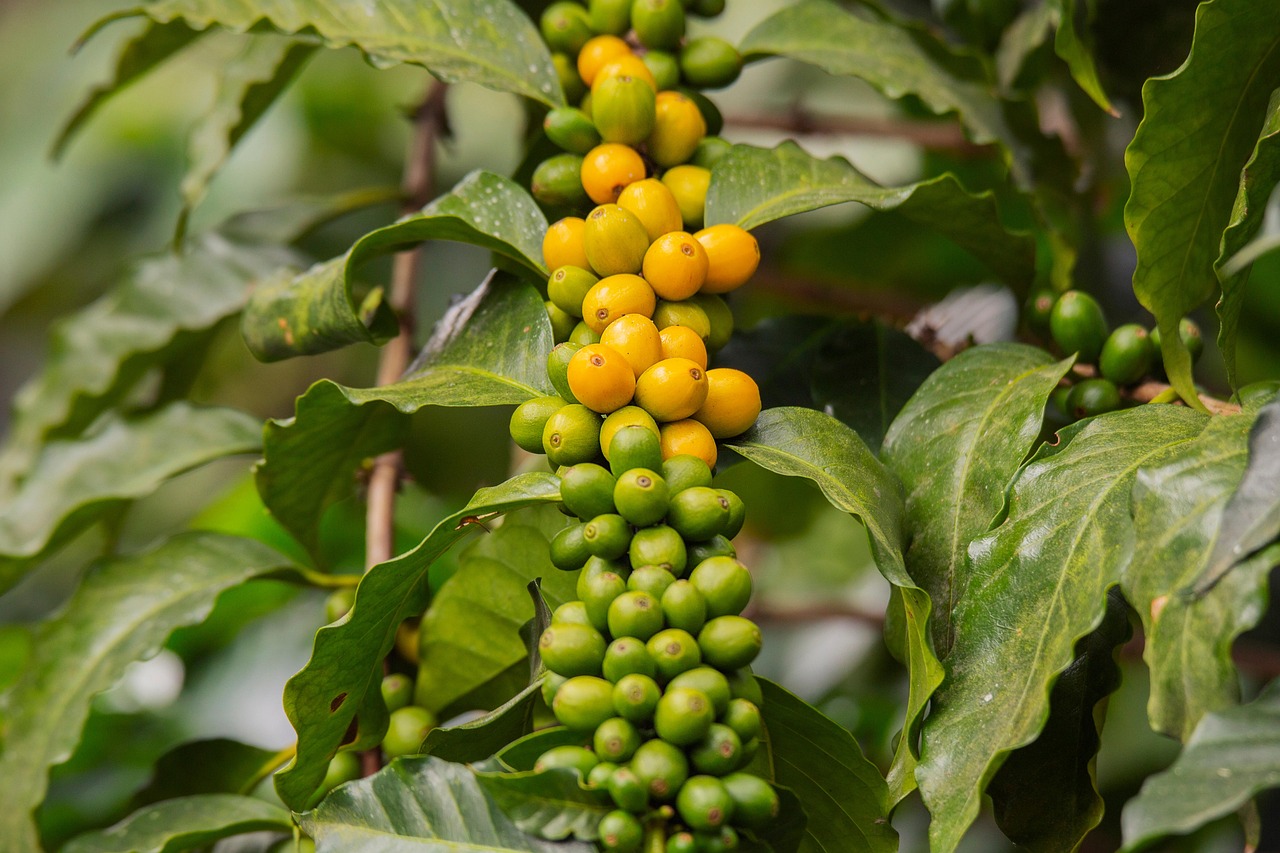Pruning coffee trees is essential for improving yield and maintaining plant health. Key techniques include selective pruning, removing dead or diseased branches, and shaping the tree to enhance air circulation and sunlight exposure.
Coffee trees, primarily grown for their beans, require careful management to maximize productivity. Proper pruning plays a critical role in achieving healthy growth and high-quality coffee production. By removing unnecessary branches and enhancing the tree’s structure, growers can ensure that their coffee plants thrive and produce the best beans possible.

Understanding the biology of coffee trees is crucial for effective pruning. These trees can grow quite tall, reaching heights of up to 15 feet. However, when cultivated for commercial purposes, they are often kept shorter for easier access during harvesting and maintenance. Regular pruning helps maintain an ideal height while promoting better air circulation and light penetration, both of which are vital for healthy growth.
Types of Pruning Techniques
There are several essential pruning techniques that coffee growers should be familiar with. Each technique serves a specific purpose and contributes to the overall health and productivity of the coffee tree.
- Selective Pruning: This technique involves removing specific branches to improve air flow and light exposure. It helps the tree focus its energy on producing high-quality beans.
- Maintenance Pruning: Regularly scheduled pruning to remove dead or diseased branches. This keeps the tree healthy and prevents the spread of pests and diseases.
- Shaping Pruning: Involves trimming branches to create a balanced structure. A well-shaped tree is easier to harvest and tends to produce better yields.
- Rejuvenation Pruning: Used for older trees that have slowed in production. This technique involves cutting back the tree significantly to encourage new growth and a fresh crop.
Each of these techniques can be adapted based on the specific needs of the coffee tree and the goals of the grower. Timing is also essential when applying these techniques. Generally, pruning should be done during the dry season when trees are less stressed and can recover more effectively.

Benefits of Pruning Coffee Trees
Implementing effective pruning techniques provides numerous benefits for coffee growers. Understanding these advantages can help motivate growers to prioritize proper pruning practices.
- Improved Yield: Pruning increases sunlight penetration and air circulation, both of which are crucial for optimal bean production.
- Enhanced Quality: By focusing growth, coffee beans produced from well-pruned trees tend to have better flavor profiles and quality.
- Pest Management: Regularly removing dead or diseased branches reduces the risk of pests and diseases that can affect the entire crop.
- Easier Harvesting: Keeping trees at a manageable height simplifies the harvesting process, making it quicker and more efficient.
The ideal approach to pruning varies depending on the coffee variety being cultivated. Arabica and Robusta coffee trees may require different strategies due to their unique growth patterns and characteristics. Growers should research the specific needs of the variety they are working with to tailor their pruning techniques accordingly.
Timing and Tools for Pruning
The timing of pruning is crucial for maximizing benefits. Typically, growers should prune after the harvest season but before the onset of new growth in the spring. This timing helps prevent damage to developing buds while allowing the tree to recover efficiently.

In terms of tools, having the right equipment is essential for successful pruning. Here are some commonly used tools:
| Tool | Description |
|---|---|
| Hand Pruners | Ideal for small branches and precise cuts. |
| Loppers | Useful for cutting thicker branches that are hard to reach. |
| Saws | For larger branches that require more force to cut through. |
| Pruning Shears | Best for shaping and fine-tuning smaller areas of the tree. |
Using sharp, clean tools is vital as it ensures clean cuts which promote faster healing in the tree. Dirty tools can introduce diseases that could jeopardize the health of the coffee plants.
In summary, mastering essential pruning techniques is fundamental for any coffee grower aiming for a successful harvest. By understanding when and how to prune effectively, growers can enhance both yield and quality while maintaining healthy coffee trees in their orchards.

Understanding the Growth Cycle of Coffee Trees
To effectively prune coffee trees, it is essential to understand their growth cycle. Coffee plants go through various stages, each requiring different care and attention. Recognizing these stages can aid in determining the best times to prune.
Growth Stages of Coffee Trees
The growth cycle of coffee trees can be divided into several key stages:
- Germination: This is the initial stage where seeds sprout into seedlings. Proper care is critical during this stage to ensure healthy development.
- Vegetative Growth: After germination, the seedlings grow leaves and roots. This phase can last several months, during which the plant requires ample light and nutrients.
- Flowering: The plants produce flowers that eventually turn into coffee cherries. This stage is crucial for future yield, making it imperative to maintain plant health through pruning and care.
- Fruit Development: Following flowering, the cherries grow and ripen. This stage can take several months, depending on environmental conditions.
- Harvesting: Once the cherries are ripe, they are harvested. This is the culmination of the coffee growth cycle and requires careful timing and management.
Understanding these stages allows growers to schedule their pruning activities effectively. For instance, pruning during the vegetative growth stage can help shape the tree and prepare it for optimal fruit production.
Pruning Strategies Based on Growth Stages
Different pruning strategies can be applied at various growth stages. Here are some recommended techniques tailored for each stage:
1. Germination and Seedling Stage
During this early stage, pruning is minimal. However, it is crucial to monitor seedlings for any signs of disease or pests. Removing unhealthy plants can prevent problems from spreading.
2. Vegetative Growth Stage
This is where selective pruning becomes valuable. Focus on:
- Thin Out Crowded Branches: Remove weaker branches to allow sunlight to reach more leaves, promoting healthy growth.
- Shape the Tree: Trim branches to create a balanced structure that facilitates easy harvesting later on.
- Remove Dead or Diseased Leaves: Regularly check for any unhealthy foliage and remove it to prevent disease spread.
3. Flowering Stage
During flowering, it is important to minimize pruning to avoid damaging buds. However, light trimming may be necessary to remove any dead branches that could hinder flowering.
4. Fruit Development Stage
In this phase, focus on:
- Support Heavy Branches: As cherries develop, some branches may require support to prevent breakage.
- Remove Unripe Cherries: Trimming unripe or damaged cherries allows the tree to focus its resources on ripening healthy fruit.
The Role of Environmental Factors in Pruning
Environmental factors play a significant role in how and when coffee trees should be pruned. Factors such as climate, soil quality, and local pests can influence pruning decisions.
1. Climate Considerations
The climate in which coffee trees are grown can dictate when pruning should occur. In regions with distinct wet and dry seasons, pruning should generally be done before the rainy season to ensure the tree heals properly before new growth begins.
2. Soil Quality
The health of the soil directly impacts the overall health of coffee trees. Well-nourished soil leads to stronger trees that can better withstand the stresses of pruning. Regular soil testing helps growers determine if additional nutrients are needed before or after pruning.
3. Pest Management
Pests can pose a significant threat to coffee trees. Pruning plays a vital role in pest management by:
- Reducing Shelter: Pruning removes areas where pests can hide and breed.
- Improving Airflow: A well-pruned tree has better airflow, reducing humidity and discouraging pest infestations.
The Importance of Disease Prevention in Pruning
Disease prevention is another critical aspect of pruning coffee trees. Certain diseases can severely impact yields if not managed properly. Pruning helps mitigate these risks by maintaining plant health.
Common Diseases Affected by Pruning
Several diseases can threaten coffee trees, including:
- Coffee Leaf Rust: A fungal disease that attacks leaves, leading to defoliation. Regular pruning helps improve air circulation, reducing humidity that fosters this disease.
- Canker Diseases: Fungal infections that cause dead areas on branches. Removing infected branches can prevent further spread.
- Pests like Coffee Borer Beetle: Pruning weakens the tree’s defenses against pests that can cause significant damage over time.
By understanding how to utilize pruning as a tool for disease prevention, growers can safeguard their investments and ensure a healthy crop year after year.
Pruning Techniques for Different Coffee Varieties
Different coffee varieties may require unique pruning techniques to achieve optimal growth and production. Understanding the characteristics of each type can help growers tailor their approaches effectively.
Arabica Coffee Trees
Arabica coffee is known for its superior flavor and quality. However, it is also more susceptible to certain diseases and pests. Effective pruning for Arabica involves:
- Light Pruning: Arabica trees benefit from light pruning to shape the canopy without stressing the plant. This helps maintain healthy growth while maximizing sunlight exposure.
- Selective Removal: Focus on removing lower branches and any that are overcrowded, which promotes better airflow and reduces disease risk.
- Maintaining Height: Keeping the tree at a manageable height is crucial for ease of harvesting. Regularly trim back taller branches to maintain an optimal height.
Robusta Coffee Trees
Robusta coffee is hardier and has a higher yield compared to Arabica, but its beans are generally considered inferior in taste. Pruning techniques for Robusta include:
- Aggressive Pruning: Robusta trees can handle more aggressive pruning than Arabica. This involves cutting back branches to promote new growth and larger yields.
- Disease Prevention: Regularly remove any diseased or damaged branches, as Robusta is less sensitive to stress, allowing for more robust recovery.
- Shaping for Sunlight: Ensure that the tree structure allows for maximum sunlight penetration, which can enhance the overall health of the plant.
Advanced Pruning Techniques
Beyond basic pruning methods, advanced techniques can further enhance the health and productivity of coffee trees. Here are some practices to consider:
Espalier Pruning
This technique involves training the coffee tree to grow flat against a support structure. It can be particularly effective in small spaces or urban environments. Benefits include:
- Space Efficiency: Espaliered trees take up less horizontal space, making them ideal for limited areas.
- Improved Access: Easier access to coffee cherries for harvesting and maintenance.
- Enhanced Airflow: The open structure allows for better airflow, reducing the risk of disease.
Multi-Branch Training
This method encourages multiple strong branches to develop instead of a single trunk. This technique is beneficial because:
- Increased Yield: More branches mean more potential coffee cherries.
- Plant Stability: A multi-branch structure can provide better support against wind and heavy rain.
The Role of Fertilization Post-Pruning
After pruning, fertilization is essential to promote healthy growth and recovery. Providing nutrients can significantly impact the tree’s ability to regenerate after trimming.
Nutrient Requirements
Coffee trees require a balanced mix of nutrients for optimal growth. Key nutrients include:
- Nitrogen: Essential for leaf development and overall growth.
- Phosphorus: Important for root development and flowering.
- Potassium: Enhances fruit quality and disease resistance.
Timing Fertilization
The timing of fertilization is crucial. It should generally occur after pruning when the tree is gearing up for new growth. This helps ensure that the nutrients are available when the tree needs them most.
Types of Fertilizers
Growers can choose from various types of fertilizers, including:
| Type of Fertilizer | Description |
|---|---|
| Organic Fertilizers | Composed of natural materials like compost or manure, promoting long-term soil health. |
| Synthetic Fertilizers | Chemically produced fertilizers that provide immediate nutrient availability but may not improve soil health over time. |
| Slow-Release Fertilizers | A type of fertilizer that releases nutrients gradually, ensuring a steady supply as the tree grows. |
Selecting the right type of fertilizer depends on soil conditions and specific nutrient deficiencies identified through soil testing.
The Importance of Regular Monitoring
Regular monitoring of coffee trees is vital for assessing health and the effectiveness of pruning techniques. Observations should include:
- Growth Rate: Monitor how quickly the trees respond to pruning and fertilization.
- Pest Activity: Keep an eye out for any signs of pest infestations that could threaten tree health post-pruning.
- Disease Symptoms: Early detection of diseases can help mitigate potential damage before it spreads.
This ongoing assessment allows growers to make timely adjustments to their care regimen, ensuring that their coffee trees remain healthy and productive throughout their life cycle.
Integrating Pruning with Overall Coffee Tree Management
Successful coffee cultivation is not solely about pruning; it involves a holistic approach to tree management. By integrating pruning with other practices, growers can create a comprehensive strategy that promotes robust growth and high yields.
Water Management
Effective water management is crucial for coffee trees. The right amount of water supports healthy growth and recovery from pruning. Here are some strategies:
- Consistent Irrigation: Ensure that coffee trees receive adequate water, especially during dry spells. Inconsistent watering can stress the plants, making them more susceptible to diseases.
- Soil Moisture Monitoring: Use soil moisture sensors to monitor levels. This helps to prevent overwatering and underwatering, both of which can adversely affect tree health.
- Mulching: Applying organic mulch around the base of the trees helps retain soil moisture and regulates temperature.
Soil Health Practices
Maintaining healthy soil is essential for nourishing coffee trees. Healthy soil contributes to overall tree vigor and resilience. Key practices include:
- Crop Rotation: Rotating with other crops can improve soil structure and nutrient availability.
- Organic Amendments: Adding compost and organic matter can enhance soil fertility and microbial activity, supporting tree health.
- Cover Cropping: Planting cover crops can prevent erosion, improve soil structure, and add nutrients back into the soil.
Pest and Disease Monitoring
Integrated pest management (IPM) is vital in maintaining healthy coffee trees. Regular monitoring combined with appropriate interventions can mitigate pest problems effectively. Steps include:
- Regular Inspections: Conduct routine checks for signs of pests or diseases. Early intervention can prevent larger outbreaks.
- Beneficial Insects: Encourage natural predators like ladybugs and lacewings that help control pest populations.
- Biological Controls: Use biological pest controls as needed to reduce reliance on chemical pesticides, promoting a healthier ecosystem.
Utilizing Technology in Coffee Cultivation
Technology has transformed modern agriculture, including coffee farming. Growers can leverage various tools to enhance their pruning and management practices:
- Drones: Drones can be used for aerial surveys, allowing farmers to assess tree health and identify areas needing attention from above.
- Sensors: Soil moisture sensors and weather stations provide real-time data that help inform irrigation and fertilization decisions.
- Farm Management Software: Utilizing software solutions can streamline record-keeping, allowing growers to track pruning schedules, fertilization, and pest management efforts more effectively.
Final Thoughts
The art of pruning coffee trees is a fundamental practice that significantly impacts yield and quality. By mastering essential pruning techniques, understanding the growth cycle of coffee trees, and integrating these practices with overall management strategies, growers can foster healthier plants and achieve more productive harvests.
Regular monitoring, proper fertilization, effective water management, and pest control are all critical components that complement pruning efforts. Combining these elements creates a synergistic approach that enhances the sustainability of coffee production.
As the coffee market continues to evolve, embracing innovative technologies will also play a vital role in advancing coffee cultivation practices. By adopting a forward-thinking mindset and continuously improving methods, coffee growers can ensure the long-term success of their operations while contributing to the quality of coffee enjoyed worldwide.
Ultimately, the journey of cultivating coffee is richly rewarding. With dedication to proper care and management techniques, growers can produce exceptional coffee that reflects both their hard work and the unique characteristics of their growing environment.
